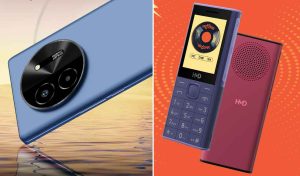Streaming live TV without mobile data or Wi-Fi may soon become a reality for millions of Indians, thanks to a revolutionary new technology called Direct-to-Mobile (D2M). Indian smartphone brand Lava International and global mobile manufacturer HMD (known for Nokia phones) are set to debut India’s first D2M-enabled phones at the World Audio Visual & Entertainment Summit (WAVES) 2025, starting May 1 at the Jio World Centre in Mumbai.
Backed by strategic collaborations with FreeStream Technologies, Tejas Networks, and Sinclair Inc., both companies are leading the charge to bring next-generation broadcasting directly to your pocket—no internet required.

What Is D2M (Direct-to-Mobile) Technology?
A New Era of Broadcast-to-Device Communication
D2M (Direct-to-Mobile) is a futuristic content delivery system that enables users to stream live television, videos, OTT content, radio, and even emergency alerts directly to mobile devices—without depending on internet connectivity. It uses terrestrial broadcast signals (in the 470–582 MHz frequency band), much like FM radio, but with upgraded capabilities for delivering video and multimedia content.
How D2M Works
Instead of relying on mobile data or Wi-Fi, D2M transmits content over broadcast infrastructure. This allows mobile devices to receive live content offline, significantly reducing the burden on telecom networks and improving reach in rural and remote areas where internet coverage is weak.
Why D2M Matters for India
Solves Real-World Connectivity Problems
India has over 700 million smartphone users, but internet penetration in rural regions remains inconsistent. D2M could play a critical role in democratizing access to:
-
Live news and entertainment
-
Educational videos
-
Emergency alerts and disaster notifications
According to India’s Information and Broadcasting Secretary Apurva Chandra, D2M could shift 25–30% of video traffic off telecom networks, making services like 5G more efficient and reliable.
Lava’s D2M Feature Phone: Built in India, for India
A Budget Device with Broadcast Power
Lava’s upcoming D2M-enabled feature phone has been entirely developed in-house by its R&D team in partnership with Tejas Networks (formerly Saankhya Labs). Targeted at users who prioritize affordability and offline access, this feature phone aligns with the Make in India and Design in India initiatives.
Key Specs of Lava’s D2M Feature Phone:
-
Display: 2.8-inch QVGA screen
-
Processor: MediaTek MT6261
-
D2M Receiver: Integrated SL3000 chip (by Saankhya Labs)
-
Network Support: GSM for voice calls
-
Battery: 2,200mAh
-
Charging Port: Micro-USB
-
Antenna: Dedicated UHF antenna for TV signal reception
This phone allows users to watch live TV, receive alerts, and consume multimedia without ever using mobile data.
HMD’s D2M Lineup: Smartphones, Tablets & More
Scaling Broadcast-Enabled Devices to the Masses
HMD Global, famous for reviving Nokia-branded phones, is set to launch a full range of D2M-capable feature phones, smartphones, and tablets. These devices will also incorporate Saankhya Labs’ SL3000 chip, making them capable of receiving content via broadcast.
But HMD isn’t stopping there. Through a strategic partnership with Sinclair Inc., the company aims to bring ATSC 3.0-like technology (widely used in the U.S.) to Indian markets. This will eventually pave the way for B2X (Broadcast-to-Everything) capabilities—potentially a game changer for 6G networks in the future.
D2M Device Pricing: How Affordable Will It Be?
Current Cost and Future Expectations
One of the biggest challenges to scaling D2M tech is cost. Currently, integrating a D2M chip into mobile hardware adds about ₹2,500 per unit. However, mass production could bring this down to just ₹120–₹200, making D2M viable for entry-level smartphones and feature phones.
According to Parag Naik, CEO of Saankhya Labs, the price drop will be a crucial factor in mainstream adoption. If executed well, D2M could become a standard feature in budget devices across India.
What’s Next for D2M in India?
Large-Scale Trials and Future Adoption
Field trials in Delhi and Bengaluru have shown promising results, with large-scale deployment trials expected to begin later in 2025. The real test will be user adoption and whether mobile manufacturers and content broadcasters continue investing in D2M infrastructure.
So far, there’s no government mandate requiring smartphone makers to include D2M support. For now, adoption will be consumer-driven, based on the appeal of free, offline access to content and emergency alerts.
Frequently Asked Questions:
Q1. What is D2M technology?
A: D2M (Direct-to-Mobile) allows users to stream TV, videos, and receive alerts on mobile devices without using mobile data or Wi-Fi.
Q2. Which companies are launching D2M-enabled phones in India?
A: Lava International and HMD Global are launching the first D2M phones at WAVES 2025.
Q3. Do D2M phones work without internet?
A: Yes, D2M phones receive content via broadcast signals, eliminating the need for data or Wi-Fi.
Q4. What is the expected price of D2M-enabled devices?
A: Currently, adding D2M increases device costs by ₹2,500, but prices may drop to ₹120–₹200 with mass production.
Q5. Will smartphones be required to support D2M in the future?
A: There is no government mandate yet. Adoption will be voluntary and based on market demand.
Q6. What content can users access via D2M?
A: Live TV, educational content, entertainment, and emergency alerts—all without using the internet.




